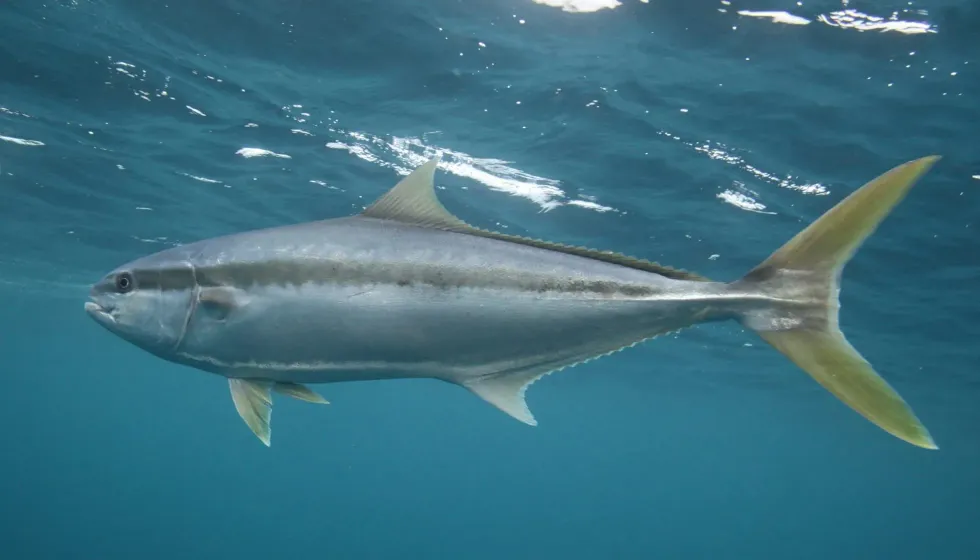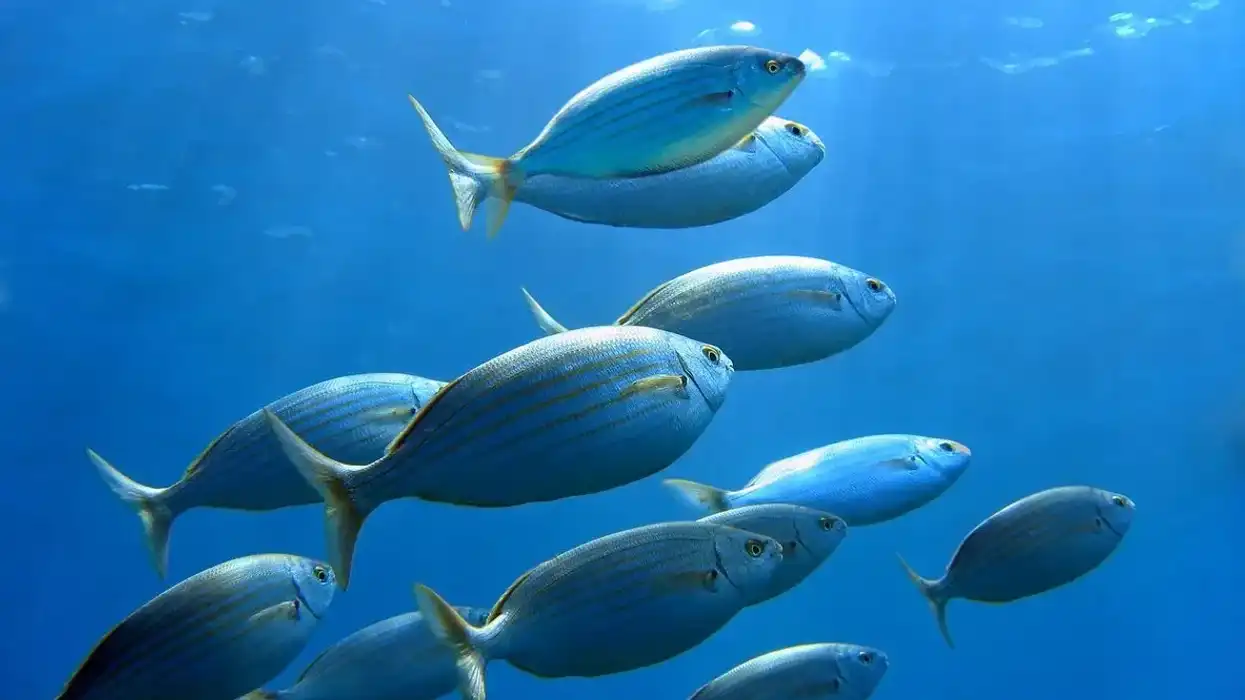A yellowtail kingfish (Seriola lalandi) is another occupant of the vastness of the ocean.
Also known as a yellowtail amberjack and great amberjack, a yellowtail kingfish is the inhabitant of the tropical and the temperate regions of the northern Pacific and the Southern Ocean.
These fishes are pelagic and are also called schooling fishes, and are seen inhabiting reefs and sandy areas in coastal waters at a depth of around 164 ft (50 m).
These fishes were previously considered to be found across all ocean waters, but now this species is said to be restricted to the Southern Hemisphere, according to the new research.
In 1833, the yellowtail kingfish (Seriola lalandi) was first described by Achille Valenciennes, a French zoologist. This fish species was given its name by Monsieur de Lalande, a famous naturalist.
There is no clarity why he used the word 'seriola', the feminine form of 'seria', meaning 'a large earthenware pot' as the name for the fish, though the second word 'lalandi' was derived from his last name, Lalande.
A yellowtail kingfish is scientifically known as Seriola lalandi. Similar fishes to yellow amberjacks found in the Northern Hemisphere are Seriola dorsalis and Seriola aureovittata.
After reading about the yellowtail kingfish, you may enjoy reading about the Japanese amberjack and amberjack.
Yellowtail Kingfish Interesting Facts
What type of animal is a yellowtail kingfish?
A yellowtail kingfish is a fish of the Southern Hemisphere waters. These fishes are shallow-water fishes found at a depth of 164 ft (50 m). These coastal fish were first described and classified by the French zoologist Achille Valenciennes in 1833.
What class of animal does a yellowtail kingfish belong to?
A yellowtail kingfish, or yellowtail amberjack, is a fish and belongs to the class Actinopterygii in the phylum Chordata and kingdom Animalia. Seriola lalandi further belongs to the order Carangiformes and to the family Carangidae, the family of ray-finned fishes which includes fishes like jacks and jack mackerels.
How many yellowtail kingfish are there in the world?
Yellowtail kingfish are found in many parts of the Southern Ocean. There is no proper count of the population of Seriola lalandi available as of now.
Where does a yellowtail kingfish live?
A yellowtail kingfish is the occupant of the North Pacific Ocean and the Southern Ocean. These sea fishes are said to have circumglobal distribution across subtropical waters. Their distribution extends along the eastern Pacific Coast, extending right from southern California to the Baja California Peninsula.
What is a yellowtail kingfish's habitat?
A yellowtail kingfish is found along rocky reefs, kelp beds, and all across offshore islands. In the summer, they are found beneath kelp paddies at a depth of 748 ft (228 m).
Who do yellowtail kingfish live with?
A yellowtail kingfish is found living in groups of its own kind near the coast. This member of the trevally and jacks family is also raised in fish schools with other fishes indicating their social behavior.
How long does a yellowtail kingfish live?
A yellowtail kingfish (Seriola lalandi) has a maximum lifespan of 12 years. On average, many of these fishes are seen surviving for no more than five to six years. The female fish reaches reproductive maturity at two to three years of age and produces a spawn of around 150 eggs on average.
How do they reproduce?
These fishes show broadcast spawning. The courtship display between males and females lasts for around 30-90 minutes. After the courtship display and mating, the female spawns first than the male fish but it lasts only for 20 seconds.
The process of spawning occurs only in water with a temperature of 62 F (17 C). Around 150 eggs are present in one spawn out of which only 100 are fertilized. A larger fish produces 3,914,000 eggs and smaller ones produce 458,000 eggs annually.
What is their conservation status?
According to the IUCN Red List, this species is placed in the Least Concern category of fish. There are no threats imposed on them currently, but overfishing can be a reason for their decreasing numbers in the future.
Yellowtail Kingfish Fun Facts
What do yellowtail kingfish look like?
Overall the body of a Seriola lalandi is a color of blue and indigo, and there's a hint of silver on their sides and belly. There is a presence of bronze strips that turn yellow on reaching the tail region, giving them the name.
Apart from this, they do not show sexual dimorphism and are bilaterally symmetrical. This species is recognized by their distinct yellow tails but the coloration fades as the fish ages.
* Please note this is an image of yellowtail snapper and not a yellowtail kingfish. If you have an image of a yellowtail kingfish, please let us know at hello@kidadl.com.
How cute are they?
Many may not find them cute because of their very big size, however these aquatic creatures are absolutely beautiful in appearance with their unique yellow coloration of their caudal and tail fins.
How do they communicate?
These fishes have their own unique way of communicating. This species picks up electric signals from the water current to sense possible predators around them. They also understand the use of gestures and motions, and they interact with their mates during the mating season via a courtship display.
How big is a yellowtail kingfish?
A yellowtail kingfish (Seriola lalandi) is a large-sized fish. An average adult yellowtail kingfish may grow up to a size of 8.2 ft (2.54 m) in length. This shows that they are really large in size. They are a little larger than the coelacanth.
How fast can a yellowtail kingfish swim?
The yellowtail kingfish (Seriola lalandi) are really fast swimmers. The average swim speed of these fishes is not known but the observations suggest that they swim really fast. Their yellow caudal fin has a small surface area that presents little turbulence providing them with excellent power and swimming ability.
How much does a yellowtail kingfish weigh?
Since a Seriola lalandi grows really large in size, they weigh a lot too. On average, a yellowtail kingfish may weigh around 80 lb (36 kg). The maximum recorded weight is 154.7 lb (70 kg).
What are the male and female names of the species?
The male and the female do not really have separate names and are referred to by the same name. They also appear very similar physically, so the best time to distinguish between them is during the process of mating.
What would you call a baby yellowtail kingfish?
A baby yellowtail kingfish is known as a juvenile. The juvenile assumes adult coloration when it grows to around 12 in (30 cm).
What do they eat?
A yellowtail kingfish at the larval stage are planktivores while adults feed on a variety of fishes such as squids, sardines, anchovies, and flying fish varieties like the California flying fish. This is an indication of the versatility of their diet and how it changes as they mature.
Are they poisonous?
A yellowtail kingfish is not at all poisonous. Their oily flesh is actually eaten in various parts of the world.
Would they make a good pet?
These fishes are really big and mean for the wild. They may be kept in aquariums under proper expert care and supervision. However, humans may not be able to provide them with the habitat and the environment they require.
Did you know...
In Sydney Harbour in the '70s, kingfish traps were introduced for the purpose of fishing. These traps were so powerful that they wiped out 60% of the larger amberjack population. Later on, their use was prohibited by the Ministry of the Fishery.
The alternate names for this species are kingie, yellowtail kingfish, Tasmania yellowtail, Californian yellowtail, king amberjack, kahu, and silver kingfish. Yellowtail kingfish is not related to king mackerel, often referred to as a kingfish. They just have similar names.
When you compare features of kingfish vs yellowtail kingfish, you will realize that the yellowtail amberjack (or yellowtail kingfish) is a pelagic, schooling fish, usually seen around Australia. Whereas, the kingfish can be found across a wider habitat range.
Yellowtail kingfish is used with tuna extensively in Japanese cuisine as they taste well together. This fish may resemble tuna, however, they do not belong to the same family.
Do people eat yellowtail kingfish?
Yellowtail kingfish is enjoyed as a delicacy, especially in Asia. They are popular for their white oily flesh and strong taste. They can either be grilled in fillets or enjoyed as barbecue sashimi fish.
What is the biggest kingfish ever caught?
The biggest caught kingfish was a kingfish mackerel that weighed around 93 lb (42 kg) near the shore of San Juan, Puerto Rico. The fish was caught by the fisherman Steve Graulau by successfully spearfishing yellowtail kingfish.
Here at Kidadl, we have carefully created lots of interesting family-friendly animal facts for everyone to discover! Learn more about some other fish from our yellowtail damselfish facts and tambaqui fish facts pages.
You can even occupy yourself at home by coloring in one of our free printable Yellowtail Kingfish coloring pages.










